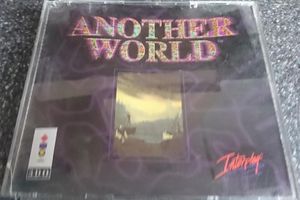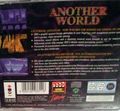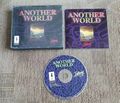Another World

Overview
- Full Name: Another World
- Code:
- Type: Platform
- Developer: Interplay Productions, Lil' Gangsters Entertainment
- Publisher: Interplay Productions
- Language: English, French
- Release Date: 1994
- Region: EU
- Barcode:
- Local Title:
- Rarity: 1
- Notes: This was called Out of this World in North America and Outer World in Japan
Summary
Another World, known as Out of This World in North America, is a 1991 cinematic platformer action-adventure game designed by Éric Chahi and published by Delphine Software. The game tells a story of Lester, a young scientist who, as a result of an experiment gone wrong, finds himself on a dangerous alien world where he is forced to fight for his survival.
Another World was innovative in its use of cinematic effects in both real-time and cutscenes, which earned the game praise among critics and commercial success. It also influenced a number of other video games and designers, inspiring such titles as Ico, Metal Gear Solid, Silent Hill, and Delphine's later Flashback.
Gameplay
Another World is a platform game, featuring a control scheme where the player uses either the keyboard, joystick or gamepad to make the protagonist run, jump, attack and perform other, situation-specific actions, such as rocking a cage back and forth. In the initial part of the game, the player's character Lester is unarmed. He is able to kick at small creatures, but is otherwise defenseless.
Later in the game, the player acquires a laser pistol from a fallen foe. The pistol has three capabilities: a standard fire mode, the ability to create force fields to block enemy fire, and a powerful charged shot that can break through force fields and some walls.[5] Enemies also have the same capabilities, requiring the player to take advantage of the three gun modes and the environment to overcome them.
Lester and his alien ally cannot sustain any damage, and the game ends immediately if either of them is struck by a projectile or comes in contact with an animal or an environmental hazard. However, the game uses numerous checkpoints enabling the player to keep restarting at the last point indefinitely. On the Amiga and older consoles without the ability to save a game, the player can write down an alphanumeric code for these checkpoints and re-enter it when restarting the game later. In any given scene, the game provides no clues as to what the player should do next, features no HUD except for an oxygen bar during the swimming sequences, and no on-screen text; and the characters the player meets speak in an unintelligible alien language.
Plot
The protagonist of the game is Lester Knight Chaykin, a young genius physicist. In the opening cinematic, Lester arrives at his high-tech underground laboratory in his Ferrari 288 GTO during a thunderstorm and goes to work on his experiment using a particle accelerator, attempting to reconstruct what happened when the universe was born. Immediately before the particles reach their intended destination, a lightning bolt strikes the laboratory and interferes with the accelerator, causing an unforeseen particle fusion and an explosion, opening a hole in time and space and teleporting Lester to a barren, alien planet.
After evading a number of dangerous indigenous animals, Lester is captured by a race of humanoid aliens and taken to a subterranean prison camp. Lester escapes along with an alien captive known as "Buddy" and the two of them must evade capture while travelling through a series of dangerous environments, battling alien soldiers and wild creatures while solving numerous puzzles in order to survive. The duo traverse the prison complex, a cave system and a tower structure. In the game's climax, Lester is severely wounded by one of the aliens, but with the help of his alien friend, manages to kill his attacker and escape. After reaching the top of the tower, Lester collapses, but is promptly joined by Buddy, who picks Lester up and the two escape on a dragon-like creature, flying off to the horizon.
Development and Release
The game's French designer Éric Chahi had previously worked as a game programmer and then as a graphic designer for video games since 1983. It was the success of his earlier work with Paul Cuisset as a graphic designer for the adventure game Future Wars for Delphine Software and its royalties that gave him the chance to develop Another World "without any constraint of any sort or any editorial pressure." After Future Wars was released in 1989, Chahi had the choice either to work on Cuisset's next game, Operation Stealth, or create his own game. As "there had been many books and tools released to develop easily on the Amiga at that time," Chahi felt confident that he could go back to programming.
The game was influenced by works that Chahi liked at the time. The art and atmosphere were influenced by science fiction books such as Dune, artists such as Michael Whelan, and comic illustrators such as Richard Corben. Manga such as Dragon Ball influenced the way it suggests a lot with very little, character blurring effects, and charging power attacks.
In August 1989, Chahi was impressed by the flat-color animations that the Amiga version of Dragon's Lair had and thought that it would be possible to use vector outlines to create a similar effect using much less computer storage. After first attempting to write the graphical routines in C, he turned to assembly language. He wrote a polygon routine for the Motorola 68000 on an Atari ST to test his theory, with much success. Later, he found that he could run the code on the Amiga platform and achieve a frame rate of about 20 frames per second, later recognizing this as "a major turning point in the creation of the game" and the point where he knew the polygon approach would work. He was able to take advantage of the Amiga's genlock capabilities to create rotoscoped animations with the polygons, using video recordings of himself performing various actions. Though he had tried to use smaller polygons (which Chahi called "pixigons") to construct the backgrounds for the scenes based on Deluxe Paint artwork, the process of creating them was excruciatingly slow, and he returned to using bitmapped images.
While Chahi had a clear idea of how to implement his game engine, he mostly improvised when creating the actual content of the game, allowing the game to develop "layer by layer without knowing where it was going."He planned on creating a science fiction game that was similar to Karateka and Impossible Mission. Because he wanted to create a dramatic, cinematic experience, the game features no HUD or dialog, giving the player only a representation of the surrounding game world during both gameplay elements and the cutscenes progressing the story. However, with no idea of the technical limitations he would face while building out the story, he focused more on creating ambiance, rhythmic pacing, and narrative tension to the game. Chahi resorted to developing his own tool with a new programming language through GFA BASIC coupled with the game's engine in Devpac assembler, to control and animate the game, interpreted in real-time by the game engine, effectively creating his own animation sequencer.
With the creation of the tools needed for building out the rest of the game by December 1989, Chahi began working on the introductory sequence as a means to validate the full capacities of his engine. The introduction sequence also gave Chahi the chance to explore the types of cinematics he could create through the engine. Chahi later considered this the "first step in the improvisation process" that he used throughout the rest of development. He finished the game's introduction sequence in early 1990 and started working on the first level. Chahi worked at the game at a linear pace, developing each section of the game in chronological order and influenced by his own personal feelings and attitude at the time. For example, as Chahi recognized he was trying to create a game on his own, the first portions of the game evoke loneliness and isolation, reflecting Chahi's mood at the time. He did not have the original intention of the character meeting an ally, but again described the improvisation approach led him to include the alien friend, and had included specific cinematics that showed a close up of the alien to help the player imagine this world.
Later in the game's development, Chahi added laser pistols, including the one that Lester carries for several effects. The idea was influenced by the Star Wars franchise, but added depth to the gameplay by giving the player more options. He also found that repeated laser fire by the enemies helped to enunciate the rhythm of the game. Chahi would later add in the plasma ball that increased the available strategy to players. Several points in the game use elevators or teleporters to move Lester between levels; Chahi had used these instead of stairways, as it was difficult to produce proper animation for these.
After 17 months of development, Chahi was only about one-third finished with the game, and realized that this rate would have been impractical. He began to take steps to simplify the development, including reusing background graphics and creating building blocks that allowed him to focus more on the game's puzzles. At the same time, he began to seek a publisher for the game. He first spoke to his former employer, Delphine Software, but also sought other distributors. One, Virgin Interactive, was favourable to Chahi's game but had suggested that he change it to a point-and-click style adventure game. Chahi had considered changing the game in line with this request but realized "the effort to do this would have been too huge, and some friends who played the game loved it."Ultimately, he accepted Delphine's offer in June 1991, and set a tentative release date in November. To meet this deadline, Chahi used storyboards to sketch out the rest of the game's plot, balancing the overall pacing of the game. One ending captured on these storyboards, but abandoned, was Lester becoming the leader of the alien world. Chahi also argued for his own cover art for the game even with the time crunch for release; he had been disappointed in cover art that was foisted on his games by previous publishers and insisted he be allowed to create it for this game.[16] The game was finished in 1991, which inspired the game's tagline: "It took six days to create the Earth. Another World took two years"; Chahi noted his own exhaustion at completing this project is mirrored in the near-death of Lester at the end of the game.
Upon publishing, Delphine did not perform a playtest of the full game, only having previously tested the first portion of the game. Delphine's U.S. publisher Interplay undertook a full playtest and Chahi fixed a number of bugs that arose from this. Interplay had also requested additional changes in the game, including making the game longer and changing the game's introduction music. Chahi was adamant about retaining the game's opening music, and had attempted to change Interplay's minds by sending them an "infinite fax", a looped piece of paper, with the message "keep the original intro music" on it. Only when Delphine's lawyer got involved and told Interplay they legally could not change the music did Interplay relax this requirement.
Reception
Magazine Reviews
| Name | Date | Region | Rating | Notes |
|---|---|---|---|---|
| No reveiws found | N/A | 2/5 |
- - Need review page
Other Versions
The original version was released in the Atari ST and Amiga, with ports spread over 30th years (Including Anniversary specials), these included MS-Dos (With Window versios later), SNES, Genesis and Mobile (including IoS and Andriod)
Credits
- Original Programming, Artwork, and Design: Eric Chahi
- Executive Producer: Brian Fargo
- Producer: Michael Conti
- Programming / Scriptor: "Burger" Bill Heineman
- Music Composed by: Andrew Dimitroff
- Music Engineers: Nick Carr, Sheridan Eldridge
- Background Graphics: Lil’ Gangsters Entertainment, Burbank, CA
- Sound Design: Paradise Post Production
- Sound Effects: Clive Mizumoto, Ron Salaises
- Music Mastering and Editing: Charles Deenen
- Sound Effects Editing: Brian Luzietti
- Line Producer: Lars Brubaker
- Opening Title Sequence: Eduardo Trillo
- Director of Quality Assurance: Kirk Tome
- Testing: Jason Taylor
- Manual Written by: Pierre Cousseau
- Manual Editor: Lars Brubaker, Scott Bennie
- Manual Design: Larry Fukuoka
- A Special Thanks to : Alan Pavlish
Soundtrack
The game's music was composed by Jean-François Freitas. The music was influenced by film soundtracks such as Back to the Future.[11] Black Screen Records released CD and vinyl versions of the 18-song soundtrack in August 2017
Linked Titles
- North American Version - Out of This World
- Japanese Version - Outer World
Media
-
Back of the case
-
Contents
-
Screenshot
-
Screenshot
-
Screenshot
-
Screenshot
-
Screenshot






